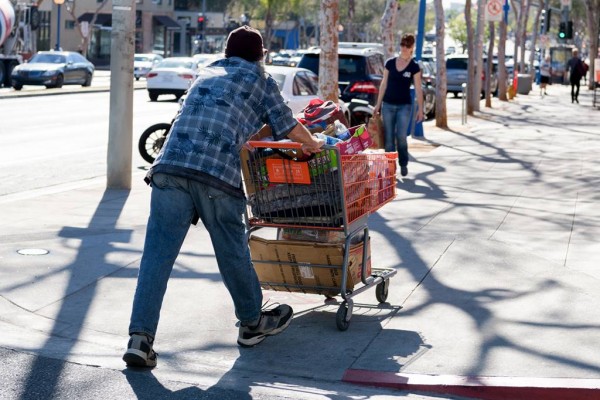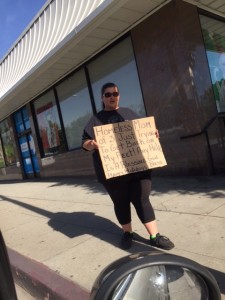
The recent brutal attack with a hatchet by an apparently homeless man on a customer at one of WeHo’s 7-Eleven convenience stores has raised concerns from some residents about whether the City of West Hollywood is doing enough to address the issue of homelessness.
And what is that issue? It depends on who you are. If you are homeless, the issue is finding food and water and a safe place to sleep. In many cases it also involves your struggle with a mental issue or a physical issue such as drug addiction. For some, the issue is simply poverty.
If you are someone who can afford to rent an apartment or buy a condo or house in West Hollywood, you may see the issue as one of safety. There have been many complaints of homeless people hiding out in parking garages, attempting to enter apartments or houses and accosting people verbally on the sidewalk. Ironically, however, while the hatchet attack stands out for its brutality, someone in West Hollywood is more likely to be physically attacked or robbed on the street from an armed robber driving into the city from elsewhere than by a person sleeping on the city’s sidewalks.
There are other West Hollywood residents who see the issue as one of aesthetics. They are upset at seeing dirty sleeping bags or unwashed homeless men and women sitting on sidewalks. Next door Beverly Hills, they claim, doesn’t have a homeless issue. (That’s a claim that Beverly Hills would reject, although that city is fortunate enough to have West Hollywood located between it and the much poorer neighborhood of Hollywood, whose streets have many makeshift sidewalk tents. Think of WeHo as the barrier island that blunts the force of homeless on its more-affluent sister city.)
So what is the City of West Hollywood doing to address this incredibly complex issue that is affecting all of Los Angeles County? WEHOville reached out to City Hall for details. This article is the first in a series from the City of West Hollywood’s response outlining how it sees the homelessness issue from the perspective of the homeless and of local residents and what it is doing about it.
WEHOville welcomes comments from readers. However, n this case we won’t accept comments until the last piece in the series is published on this coming Thursday. That’s in the hope that readers will take the time to read the entire series and then ask better informed questions and make better informed suggestions.
The City of West Hollywood: Our Response to Homelessness
We think home is where it all begins. In 1984, the idea for a City of West Hollywood was proposed by an unlikely coalition of LGBT activists, seniors, and renters. Then an unincorporated portion of Los Angeles County, it was mainly comprised of renters (85%), and the community was fearful that the imminent expiration of county rent control laws would cause mass evictions and leave many renters vulnerable to homelessness.
Not long after the city was incorporated, the City Council adopted its landmark Rent Stabilization Ordinance. Upon its adoption, this was one of the strictest rent control laws in the country. The city has an entire division dedicated to rent stabilization and housing programs that promote a strong and vibrant residential community and helps keep people in their rent-controlled units. The division also facilitates the development of new and affordable housing; the city’s Inclusionary Housing law requires 20% of multi-unit residential development projects to be reserved for lower- and moderate-income households.

Additionally, just after the City of West Hollywood was incorporated, it established its Social Services program to provide much-needed supportive services to residents. Our city stands apart in its approach to providing a continuum of vital care for its community members; no other city of its size and kind provides the level of social service funding for its residents. Over its history, the city has provided millions of dollars to fund programs for West Hollywood community members in need. These include services for seniors; people with HIV and AIDS; members of the LGBT community; people with disabilities; alcohol and drug use recovery programs; support programs for Russian-speaking immigrants; food programs, and health care services for people who are uninsured. Today, the city’s Social Services Division budgets more than $4.5 million per year in funding critical support to programs that impact thousands of people in West Hollywood.
The city’s rent control and inclusionary housing laws ensure that thousands of residential housing units remain affordable. Our housing policies, combined with our social services programs, are tools that are critical components in our decades-long fight to protect and care for our residents and keep them from falling into homelessness.
Despite the tools that the city has developed, homelessness in the region has spiked to record numbers in jurisdictions large and small across the state. In a comprehensive review of the depth and breadth of the City of West Hollywood’s strategic approaches to homelessness, it is important to note that the gaping hole in this continuum of services/care is permanent, supportive, affordable housing. This is not just a challenge for West Hollywood, but throughout Los Angeles County and the entire State of California.
The city’s approach to homelessness remains true it its core values of respect and support for people. Our approach is compassionate, caring and supportive. Homelessness is an extremely complex social problem that impacts the quality of life in our community and there are, unfortunately, no easy solutions. Many of our homeless community members are living on the streets because of mental illness or substance abuse, in some cases both. Often the complex health diagnoses that lead to homelessness may be criminal in nature like public intoxication, loitering, trespassing, public urination/defecation, disturbing the peace and more. However, study after study shows that jailing and prosecuting homeless individuals won’t eliminate homelessness and can often exacerbate the obstacles in their finding employment and housing.

To further assist the community in addressing the complicated web of issues due to homelessness and to provide better service to this at-risk population, the City of West Hollywood has created the Homeless Initiative. In September of 2016, the City Council approved Guiding Principles for the city’s response to homelessness and formed a City Council subcommittee to address these issues.
Effectively addressing homelessness requires a multi-disciplinary, multi-agency, collective response. We are fortunate in West Hollywood to have resources in multiple departments and agencies, and a deep commitment to work together to address this very challenging issue.
There are three key city departments — Human Services & Rent Stabilization, Public Safety, and Economic Development — addressing and responding to homelessness, along with various contract providers, ranging from the West Hollywood Sheriff’s Station, Ascencia, Step Up on Second, the Los Angeles LGBT Center, the West Hollywood Library and the West Hollywood Chamber of Commerce.
The city’s website includes a complete listing of contracted agencies and organizations that provide outreach and services to people who are homeless in West Hollywood. Information, including hours and scope of services, is available at www.weho.org/homeless.
In addition, the Homeless Initiative launched a Concern Line — (323) 848-6590 — for community members to share their concerns about people experiencing homelessness in West Hollywood. Messages left on the Concern Line will be followed up on by city staff, contracted social services providers or law enforcement.

Night and weekend, time-sensitive inquiries can be made directly to the West Hollywood Sheriff’s Station by calling 911 or for non-emergency calls (310) 855-8850.
The Homeless Initiative team consists of public and non-profit health and human services specialists, law enforcement officers as well as mental health clinicians and substance abuse providers. Although the city offers emergency food, services and shelter for people without homes, quite often our homeless community members refuse help, at least in the first few contacts. However, the Homeless Initiative’s outreach teams are steadfast and persistent in their efforts to outreach to every member of our homeless population. These efforts take time to develop trust and a rapport with individuals through numerous contacts.
Outreach teams often encounter multiple obstacles in connecting people experiencing homelessness to care because they are able to get many of their basic needs met by panhandling and other donations from generous community members. Offers of shelter, food and assistance by trained social service providers are often turned down because the individual is able to access gifts of cash, gift cards and food on a daily basis. While well meaning, these “gifts” are often barriers in the pathway to services that can ultimately lead people out of homelessness and into permanent supportive housing.
Through the Homeless Initiative, the city and its partner agencies will continue in its endeavors to chisel away at the complex challenges in addressing homelessness. And with the support and assistance from the community, together we can affect a sustainable path to move people from homelessness to the housing and services they need to thrive.
The Data
In January, West Hollywood participated in the Greater Los Angeles Homeless Count, coordinated by the Los Angeles Homeless Services Authority (LAHSA). That point-in-time count for opt-in cities, released in July 2017, showed an increase in the number of homeless individuals in West Hollywood. The official LAHSA count for 2017 was 105; up from 81 in the 2016 count. By contrast, the Los Angeles County’s homeless population increased by 23% since last year’s count. The precipitous rise, to roughly 58,000, shows that the number of people falling into homelessness is still outpacing the increased, collaborative effort to stem the surge in our regional homeless population. In neighboring City of Los Angeles, its homeless population is nearly 35,000, compared to 28,464 the year before, a 20% rise.
The LAHSA count now takes place annually, rather than every two years. Below are the figures for West Hollywood’s count since 2009, the first year the city participated.
- 2009 – 59
- 2011 – 57
- 2013 – 45
- 2015 – 43
- 2016 – 81
- 2017 – 105
The City of West Hollywood’s total of 105 homeless community members includes 92 people counted on the street, up from 77 the year before. The balance of 13 is not an actual number of people, but a figure reached using LAHSA’s pre-determined conversion factors to estimate a total count. For example, a makeshift shelter wouldn’t count as one person, but rather 1.916; a camper/RV would be counted as 2.050, etc.
In addition to the annual LAHSA count, our outreach team from Ascencia conducts an early morning count on the last Friday of each month to gauge our overnight population. The totals from the beginning of this year are:
- January – 51
- February – 17
- March – 20
- April – 24
- May – 32
- June – 29
- July – 31
- August – 37
In order to better understand the people and experiences behind those numbers, teams from LAHSA and the city’s contracted providers, including Ascencia, Step Up on Second and the Los Angeles LGBT Center, were trained to conduct LAHSA-generated demographic surveys with homeless community members in West Hollywood. The city’s Social Services Division is working with LAHSA and UCLA to further evaluate and analyze the data collected by those teams in West Hollywood Census tracts.
TOMORROW: What the City of West Hollywood’s Human Services & Rent Stabilization Department is doing about homelessness

7 months living in WeHo, Unhappy 11 open citations on a payment plan for 4 other citations can’t do payment plan I didn’t get the for in fast enough,I told them I was very I’ll w Covid could hardly focus on phone and parking enforcement could care less it didn’t matter what problem I had and how sick I was if I was half dead ticket ticket ticket ticket ticket ticket ticket I’m going to a financial hardship now because of this it’s just ridiculous now my driving record is going to be bad they don’t care I will end… Read more »